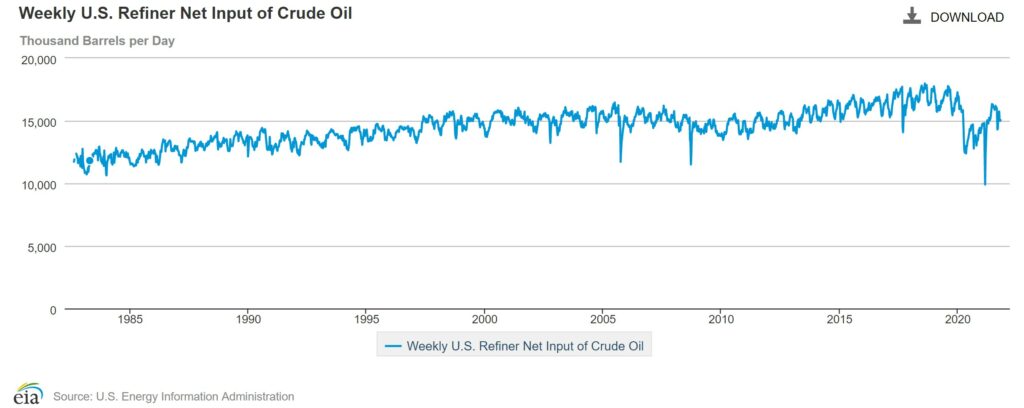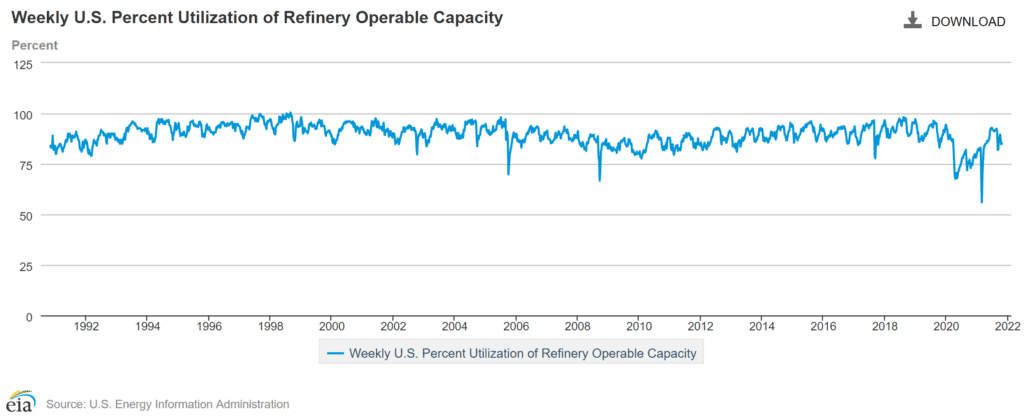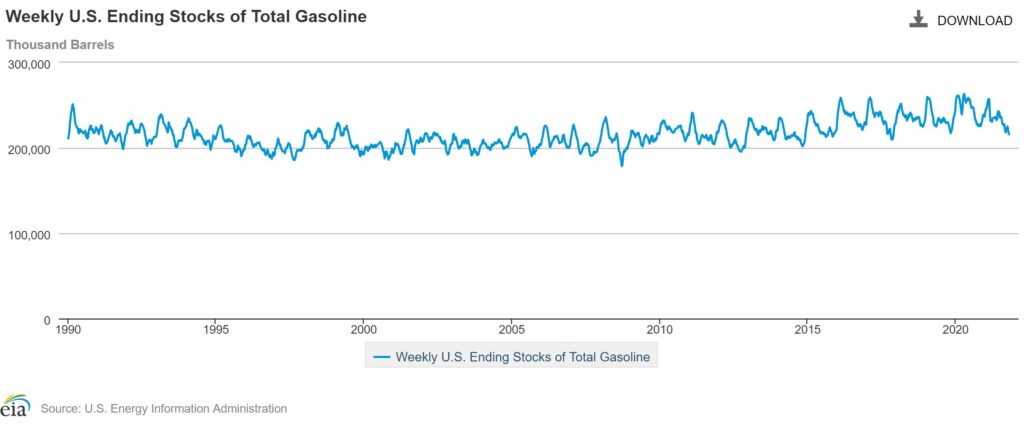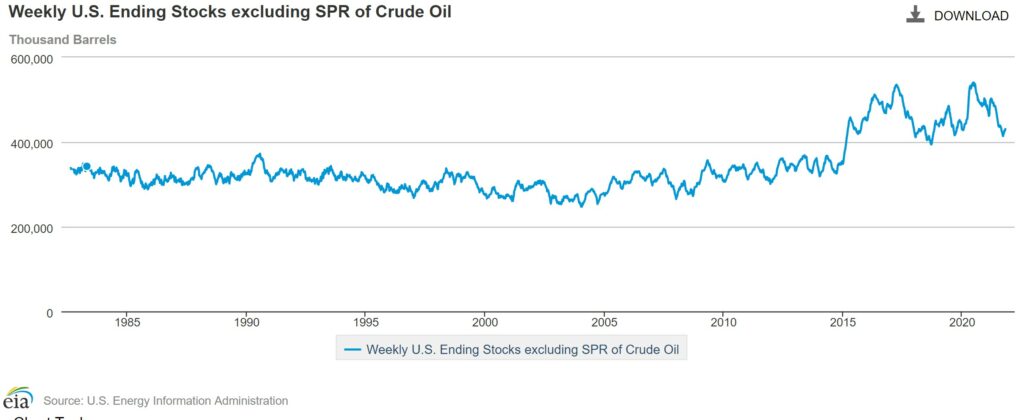Commenter and Blogger RJS, Focus on Fracking, The Latest US Oil Supply and Disposition Data from the EIA US oil data from the US Energy Information Administration for the week ending October 22nd indicated that after a modest increase in our oil imports and a modest decrease in our oil exports, we had surplus oil to add to our stored commercial crude supplies for the fourth time in five weeks and for the for the ninth time in the past thirty weeks . . . our imports of crude oil rose by an average of 430,000 barrels per day to an average of 6,254,000 barrels per day, after falling by an average of 169,000 barrels per day during the prior week, while our exports of crude oil fell by an average of 273,000 barrels per day to an average
Topics:
run75441 considers the following as important: Focus on Fracking, politics, RJS, US/Global Economics
This could be interesting, too:
Robert Skidelsky writes Lord Skidelsky to ask His Majesty’s Government what is their policy with regard to the Ukraine war following the new policy of the government of the United States of America.
Joel Eissenberg writes No Invading Allies Act
Ken Melvin writes A Developed Taste
Bill Haskell writes The North American Automobile Industry Waits for Trump and the Gov. to Act
Commenter and Blogger RJS, Focus on Fracking, The Latest US Oil Supply and Disposition Data from the EIA
US oil data from the US Energy Information Administration for the week ending October 22nd indicated that after a modest increase in our oil imports and a modest decrease in our oil exports, we had surplus oil to add to our stored commercial crude supplies for the fourth time in five weeks and for the for the ninth time in the past thirty weeks . . . our imports of crude oil rose by an average of 430,000 barrels per day to an average of 6,254,000 barrels per day, after falling by an average of 169,000 barrels per day during the prior week, while our exports of crude oil fell by an average of 273,000 barrels per day to an average of 2,787,000 barrels per day during the week, which meant that our effective trade in oil worked out to a net import average of 3,467,000 barrels of per day during the week ending October 22nd, 703,000 more barrels per day than the net of our imports minus our exports during the prior week . . . over the same period, production of crude oil from US wells was reportedly unchanged at 11,300,000 barrels per day, and hence our daily supply of oil from the net of our international trade in oil and from domestic well production appears to have totaled an average of 14,767,000 barrels per day during the cited reporting week…

Meanwhile, US oil refineries reported they were processing an average of 15,048,000 barrels of crude per day during the week ending October 22nd, 58,000 more barrels per day than the amount of oil they processed during the prior week, while over the same period the EIA’s surveys indicated that a net of 454,000 barrels of oil per day were being added to the supplies of oil stored in the US . . . so based on that reported & estimated data, this week’s crude oil figures from the EIA appear to indicate that our total working supply of oil from net imports and from oilfield production was 734,000 barrels per day less than what was added to storage plus our oil refineries reported they used during the week . . . to account for that disparity between the apparent supply of oil and the apparent disposition of it, the EIA just plugged a (+734,000) barrel per day figure onto line 13 of the weekly U.S. Petroleum Balance Sheet to make the reported data for the daily supply of oil and the consumption of it balance out, essentially a balance sheet fudge factor that they label in their footnotes as “unaccounted for crude oil”, thus suggesting there must have been a error or omission of that magnitude in this week’s oil supply & demand figures that we have just transcribed . . . however, since most everyone treats these weekly EIA reports as gospel and since these figures often drive oil pricing and hence decisions to drill or complete wells, we’ll continue to report them as they’re published, just as they’re watched & believed to be reasonably accurate by most everyone in the industry . . . (for more on how this weekly oil data is gathered, and the possible reasons for that “unaccounted for” oil, see this EIA explainer)….
Further details from the weekly Petroleum Status Report (pdf) indicate that the 4 week average of our oil imports fell to an average of 6,277,000 barrels per day last week, which was still 15.2% more than the 5,450,000 barrel per day average we were importing over the same four-week period last year . . . the rounded the 454,000 barrel per day net increase in our crude inventories came as 610,000 barrels per day were added to our commercially available stocks of crude oil, which in turn was partly offset by a 156,000 barrels per day withdrawal of oil that had been stored in our Strategic Petroleum Reserve, part of an emergency loan of oil to Exxon in the wake of hurricane Ida . . . this week’s crude oil production was reported to be unchanged at 11.300,000 barrels per day as the EIA’s rounded estimate of the output from wells in the lower 48 states was unchanged at 10,900,000 barrels per day, while an 11,000 barrel per day increase in Alaska’s oil production to 442,000 barrels per day had no impact on the reported rounded national production total . . . US crude oil production had hit a pre-pandemic record high of 13,100,000 barrels per day during the week ending March 13th 2020, so this week’s reported oil production figure was 13.7% below that of our pre-pandemic production peak, but 34.1% above the interim low of 8,428,000 barrels per day that US oil production had fallen to during the last week of June of 2016..

US oil refineries were operating at 85.1% of their capacity while using those 15,048,000 barrels of crude per day during the week ending October 22nd, up from 84.7% of capacity the prior week, but below normal utilization for early autumn refinery operations . . . the 15,048,000 barrels per day of oil that were refined this week were still 12.4% more barrels than the 13,388,000 barrels of crude that were being processed daily during the pandemic impacted week ending October 23rd of last year, but 5.9% less than the 15,998,000 barrels of crude that were being processed daily during the week ending October 25th, 2019, when US refineries were operating at what was then also a below normal 87.7% of capacity…
With the increase in the amount of oil being refined this week, the gasoline output from our refineries was also a bit higher, increasing by 12,000 barrels per day to10,072,000 barrels per day during the week ending October 22nd, after our gasoline output had increased by 455,000 barrels per day over the prior week . . . this week’s gasoline production was also 10.7% more than the 9,095,000 barrels of gasoline that were being produced daily over the same week of last year, but still 1.1% less than the gasoline production of 10,184,000 barrels per day during the week ending October 25th, 2019 . . . at the same time, our refineries’ production of distillate fuels (diesel fuel and heat oil) increased by 164,000 barrels per day to 4,581,000 barrels per day, after our distillates output had decreased by 289,000 barrels per day over the prior week . . . after this week’s increase, our distillates output was 11.0% more than the 4,126,000 barrels of distillates that were being produced daily during the week ending October 23rd, 2020, but 7.8% less than the 4,970,000 barrels of distillates that were being produced daily during the week ending October 25th, 2019..

Despite the increase in our gasoline production, our supply of gasoline in storage at the end of the week decreased for the fifth time in eight weeks, and for fifteenth time in twenty-seven weeks, falling by 1,993,000 barrels to a 47 month low of 215,746,000 barrels during the week ending October 22nd, after our gasoline inventories had decreased by 5,368,000 barrels over the prior week . . . our gasoline supplies decreased this week even though the amount of gasoline supplied to US users fell by 311,000 barrels per day to 9,323,000 barrels per day because our imports of gasoline fell by 113,000 barrels per day to 493,000 barrels per day, and because our exports of gasoline rose by 280,000 barrels per day to 813,000 barrels per day . . . after this week’s inventory decrease, our gasoline supplies were 4.6% lower than last October 23rd’s gasoline inventories of 226,124,000 barrels, and about 3% below the five year average of our gasoline supplies for this time of the year…

Even with the increase in our distillates production, our supplies of distillate fuels decreased for the eighth time in nine weeks and for the 20th time in 29 weeks, falling by 432,000 barrels to an 18 month low of 124,962,000 barrels during the week ending October 22nd, after our distillates supplies had decreased by 1,913,000 barrels during the prior week . . . . our distillates supplies fell by less this week than last because the amount of distillates supplied to US markets, an indicator of our domestic demand, fell by 409,000 barrels per day to 3,869,000 barrels per day, while our imports of distillates rose by 123,000 barrels per day to 325,000 barrels per day, and while our exports of distillates rose by 199,000 barrels per day to 1,099,000 barrels per day . . . after twenty inventory decreases over the past twenty-nine weeks, our distillate supplies at the end of the week were 20.0% below the 156,228,000 barrels of distillates that we had in storage on October 23rd, 2020, and about 8% below the five year average of distillates stocks for this time of the year…

Meanwhile, after the increase in our oil imports and the decrease in our oil exports, our commercial supplies of crude oil in storage rose for the sixth time in the past twenty-two weeks and for the 18th time in the past year, increasing by 4,268,000 barrels over the week, from 426,544,000 barrels on October 15th to 430,812,000 barrels on October 22nd, after our commercial crude supplies had decreased by 431,000 barrels over the prior week . . . after this week’s increase, our commercial crude oil inventories remained about 6% below the most recent five-year average of crude oil supplies for this time of year, but were still more than 28% above the average of our crude oil stocks at the fourth weekend of October over the 5 years at the beginning of the past decade, with the disparity between those comparisons arising because it wasn’t until early 2015 that our oil inventories first topped 400 million barrels . . . since our crude oil inventories had jumped to record highs during the Covid lockdowns of last spring and remained elevated for most of the year after that, our commercial crude oil supplies as of this October 22nd were 12.5% less than the 492,427,000 barrels of oil we had in commercial storage on October 23rd of 2020, and are now 1.8% less than the 438,853,000 barrels of oil that we had in storage on October 25th of 2019, but are still 1.1% more than the 426,004,000 barrels of oil we had in commercial storage on October 26th of 2018…
Finally, with our inventory of crude oil and our supplies of all products made from oil still near multi year lows, we are continuing to track the total of all U.S. Stocks of Crude Oil and Petroleum Products, including those in the SPR . . . we find that total oil and oil product inventories, including those in the Strategic Petroleum Reserve and those held by the oil industry, rose by 3,269,000 barrels this week, from 1,844,183,000 barrels on October 15th to 1,847,479,000 barrels on October 8th, and they are now 5,852,000 barrels higher than the six year low of five weeks earlier…
